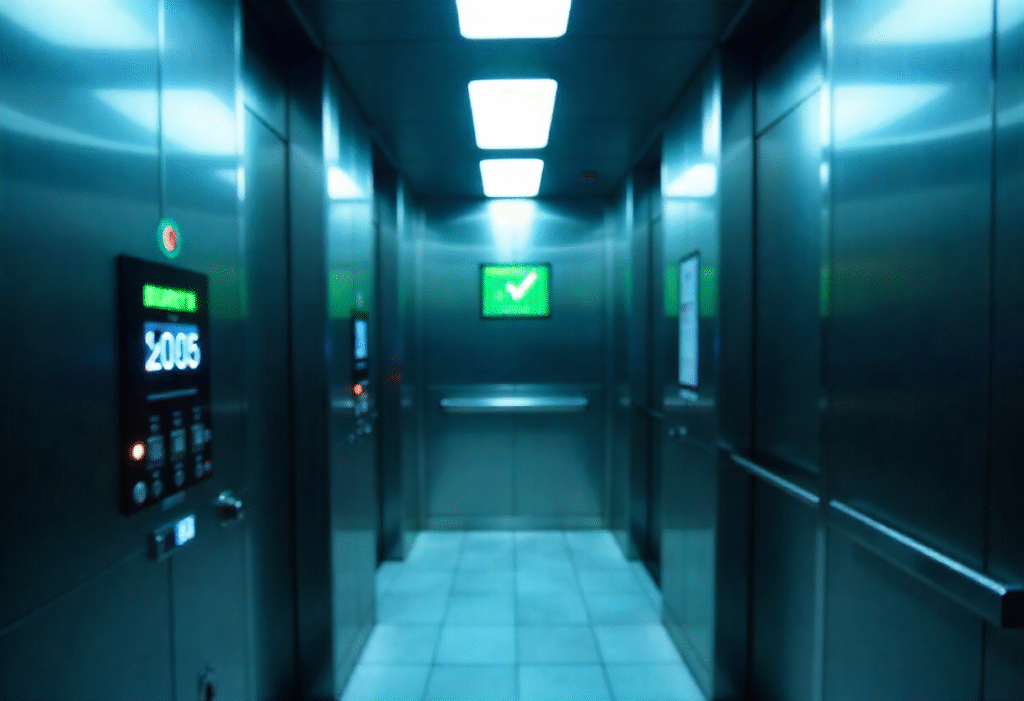Elevators, or lifts, are among the most relied-upon forms of vertical transportation in modern buildings. They allow people to move quickly and comfortably between floors, but they also come with mechanical complexities that require strict oversight. One of the simplest yet most powerful tools for ensuring passenger safety is clear signage. When you see the phrase “this sign shows when a lift is safe to use”, it means that someone has taken responsibility for verifying the safety and operational readiness of that lift. This sign bridges the technical world of maintenance engineering and the everyday reality of public use, translating complex safety inspections into a visible, easy-to-understand reassurance.
Lift safety signs are more than just visual cues—they are legal safeguards, public trust signals, and operational management tools all rolled into one. They help building managers communicate with tenants and visitors without technical jargon, letting everyone know the lift is functional, compliant, and safe.
Understanding ‘this sign shows when a lift is safe to use’
The message itself is straightforward but vital. It’s not a marketing slogan, nor is it decorative—it’s a direct statement of fact. When displayed, it means that a qualified inspector has checked the lift’s safety systems, verified that all components meet regulatory requirements, and confirmed it is suitable for passenger use.
Typically, these signs include a date of inspection, the inspector’s identification or company name, and sometimes an official stamp or certification seal. You’ll find them inside the lift car, often above the control panel, or next to the call buttons outside the lift. In high-traffic buildings like malls, hospitals, and office towers, this sign can be the difference between someone confidently stepping inside and hesitating out of uncertainty.
How Lift Safety Signs Work
The operational logic behind these signs varies depending on the building’s technology level. In traditional systems, an engineer or building maintenance staff updates the sign manually after each scheduled inspection. This could be in the form of a printed certificate in a frame, or a laminated tag with a signature and date.
In modern smart buildings, these signs may be integrated with real-time monitoring systems. Sensors within the lift detect performance metrics—door alignment, cable tension, emergency brake readiness, weight limit accuracy, and more. The safety status is then fed to a digital display or LED indicator, which automatically updates the message. If a fault is detected, the “safe to use” message is replaced by a “do not use” warning instantly.
The Legal Framework Behind Lift Safety Signs
Safety signage for lifts is not optional—it’s mandated by law in most jurisdictions. In the UK, regulations like LOLER and the Health and Safety at Work Act require routine inspections and visible confirmation of compliance. In the US, the ASME A17.1 standard outlines similar rules, and inspectors issue certificates that must be displayed. In the EU, the Lift Directive 2014/33/EU makes safety signage a legal obligation, backed by strict enforcement.
These laws ensure that both building owners and maintenance companies are held accountable. If an accident occurs and the lift was in operation without a valid safety sign, legal consequences can be severe, ranging from hefty fines to criminal charges.
When a Lift is Considered Safe
A lift earns the right to display this sign only after passing multiple tests. Engineers check:
-
Weight load capacity accuracy
-
Emergency brakes and fail-safes
-
Door sensor functionality
-
Alarm systems and intercom lines
-
Electrical and control panel integrity
-
Smooth, stable operation during travel
If even one of these areas fails inspection, the lift is marked unsafe until repairs are completed. This means the sign is not a static fixture—it’s a living status report that changes based on the lift’s real condition.
Common Features of Lift Safety Signs
Safety signs often follow standard design principles to ensure clarity. Common features include:
-
A green background or check mark to indicate safe operation
-
Bold, clear text stating the safety status
-
Inspection date and due date for the next check
-
Official logos or seals from inspection authorities
-
Durable materials that resist fading or tampering
These design elements are chosen to be instantly recognizable to people of all ages and languages.
Digital vs. Manual Safety Indicators
Manual indicators are reliable but rely heavily on human diligence. Digital safety indicators, however, provide a more dynamic and automated approach. They can display real-time data, sync with building management systems, and send alerts to maintenance teams when an issue arises. The main advantage of digital systems is speed—problems are detected and communicated instantly, reducing the risk of unsafe usage.
How to Read Lift Safety Signs Correctly
Reading a safety sign is straightforward, but misinterpretations do occur. Always check:
-
The inspection date—is it recent?
-
The validity period—has it expired?
-
Any warning symbols—are they present?
-
Notes from inspectors—do they indicate restrictions?
If the date is old or the wording unclear, treat the lift with caution and report it to building management.
Role of Maintenance Teams in Lift Safety
Behind every safety sign is a team of trained professionals ensuring the lift is in peak condition. Maintenance teams carry out scheduled servicing, respond to alerts, and conduct emergency repairs. They are also responsible for updating the safety sign promptly after inspections, making their role both technical and communicative.
Impact of Ignoring Lift Safety Signs
Using a lift without checking its safety status—or worse, ignoring a “do not use” notice—can have dire consequences. Risks include:
-
Mechanical failure during operation
-
Passenger entrapment
-
Legal liability for building owners
-
Damage to the lift requiring costly repairs
There are documented cases where ignoring safety signs has led to injuries, lawsuits, and prolonged building downtime.
Best Practices for Building Owners
Building owners should:
-
Schedule inspections ahead of expiry dates
-
Train staff to understand lift safety signage
-
Keep maintenance logs accessible
-
Use reputable inspection companies
-
Invest in clear, tamper-proof signage
By embedding these practices, owners reduce risks and build trust with tenants.
Common Misinterpretations of Lift Safety Signs
Some people mistakenly think the sign guarantees indefinite safety. In reality, it reflects the lift’s condition at the time of inspection. Others misread dates or ignore temporary warnings during maintenance. Public education is key to overcoming these misconceptions.
Technological Advances in Lift Safety Indicators
The future of lift safety signage is digital and connected. IoT sensors, AI-driven diagnostics, and predictive maintenance systems are already being deployed in smart buildings. These systems can predict component failure before it happens, keeping lifts safer for longer periods between inspections.
Case Studies of Lift Safety Compliance
In a large London office tower, implementing a digital lift safety system reduced downtime by 35%. In a Singapore hospital, real-time monitoring cut emergency repair incidents in half. These examples show how serious attention to safety signage can improve both safety and efficiency.
Lift Safety Signs in Emergency Situations
During fires, earthquakes, or power failures, lift safety signs often change automatically to display “Do Not Use” warnings. In emergencies, lifts can be dangerous due to power instability or obstruction risks. This automatic signage change is a critical part of building evacuation protocols.
How Tenants and Visitors Can Ensure Lift Safety
Users can protect themselves by:
-
Checking the sign before entering
-
Avoiding lifts with expired certificates
-
Reporting unclear or missing signs
-
Being aware of building safety procedures
Training Staff on Lift Safety Signs
Staff training should cover how to read signs, respond to faults, and communicate with building occupants. This not only keeps people safe but also strengthens the building’s overall safety culture.
Design Standards for Safety Signs
International design standards like ISO 7010 influence lift safety signage. Standards ensure the signs are clear, accessible to people with disabilities, and resistant to tampering or environmental wear.
The Role of Government Inspections
Government inspectors verify compliance and can issue orders to halt lift operations if standards are not met. These inspections are often unannounced, keeping building operators accountable.
Why Regular Maintenance is Non-Negotiable
Skipping maintenance is not just risky—it’s illegal in many places. Preventive care keeps lifts running smoothly, reduces repair costs, and ensures the safety sign remains valid.
Public Awareness Campaigns for Lift Safety
Some cities run public campaigns to educate residents on how to interpret safety signs. Posters, online videos, and community workshops all help promote safe lift usage.
Integration of Lift Safety with Building Management Systems
Integrating lift safety indicators into central building management systems allows for remote monitoring and instant alerts, making maintenance more proactive.
Common Myths About Lift Safety
Myth: “If the lift is moving, it must be safe.”
Fact: Mechanical issues can exist even while the lift operates. Always check the sign first.
Future of Lift Safety Signage
Expect more AI integration, predictive analytics, and even smartphone-based lift safety apps in the next decade. These innovations will make safety information even more accessible.
FAQs
What does “this sign shows when a lift is safe to use” mean?
It means the lift has been inspected and certified as safe according to regulatory standards.
Where is the sign usually located?
Inside the lift car near the control panel or next to the lift doors.
How often are lifts inspected?
Typically every 6–12 months, depending on local laws.
Can I use a lift if the sign is missing?
It’s not recommended. Report the issue to building management immediately.
Do digital safety signs work better than manual ones?
They provide real-time updates, making them more reliable for instant safety checks.
Who is responsible for updating the lift safety sign?
Usually the building’s maintenance team or a certified inspection company.
Conclusion
The phrase “this sign shows when a lift is safe to use” is far more than a routine notice—it’s a visible guarantee backed by engineering expertise, legal compliance, and a shared commitment to safety. By understanding, respecting, and acting on these signs, both building managers and everyday passengers can prevent accidents and ensure smooth, safe journeys between floors.



